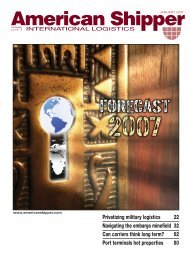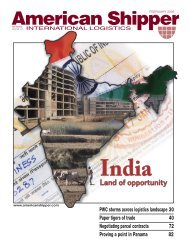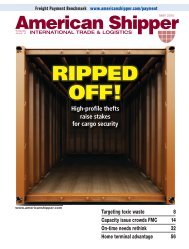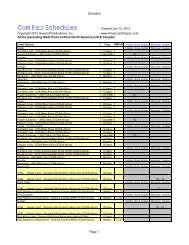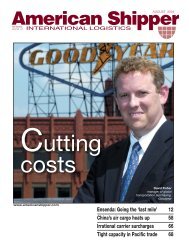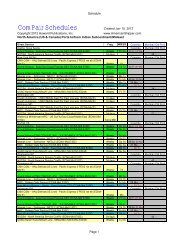McLean's - American Shipper
McLean's - American Shipper
McLean's - American Shipper
- No tags were found...
Create successful ePaper yourself
Turn your PDF publications into a flip-book with our unique Google optimized e-Paper software.
TRANSPORT / OCEANof relying solely on the federal governmentfor transportation funding.“Not only are the states the principaldecision makers and the true ‘owners’ ofthe public transportation infrastructure, thestates are increasing their spending aboveand beyond what the federal government isallocating to them,” Koch said.“This is due in large part to recognition bythe states that federal funding falls far shortof the money needed to adequately improvethe transportation system in their state. TheAlameda Corridor took 19 years from thedrawing board to the first train. This isn’tgoing to happen overnight. We’ve got toget CEOs to explain to Congress how biga problem it is to have two weeks of extrainventory in the supply chain.”For shipper John Isbell, another key voicein the national freight policy movement, theWest Coast-Asia trade lane that he relies onas director of corporate logistics for Nikeconcerns him.“The strategies adopted may buy anothermoderate year of congestion,” Isbell said.“There are a lot of plans, but no strategy atthe national or state level, and that’s scary.Congress clearly doesn’t understand the nuancesof how the supply chain operates.”“Supply chains have been honed to be morejust-in-time oriented, but that will change ascongestion mounts,” he continued.Isbell said that shippers need to communicatetheir plans better with transportationand logistics partners, which will help ensurebetter forecasting and better infrastructureplanning.Speaking about the margin betweenforecast growth and real growth, whichmany blamed for the port congestion crisisin Southern California in 2004, Isbell said:“We have failed to communicate. We can’tlisten to Drewry or others. They have to listento us because we know our own industrybetter than anyone else.”China Issues. Meanwhile, the UnitedStates’ key trading partner across the Pacifichas other problems with which to contend.China’s port and infrastructure growth continueswith abandon even though the otherside of the equation isn’t keeping pace.“If we’re not careful, we could run into theproblem of surplus supply” of terminal capacity,said Kenneth Tse, general manager ofYantian International Container Terminals.Tse said projections show that China’sterminals could be only 51 percent utilizedby 2009, with 27 million TEUs of capacitybeing added in terminals in Yantian andYangshang.However, logistics costs in China are justas big a concern for Tse. He said logisticscosts account for about 20 percent of total54 AMERICAN SHIPPER: APRIL 2006product costs in China, compared to about 6percent in North America and Europe.“Inland transportation costs in China canbe prohibitive,” he said.But, the Chinese government is spending$273 billion on a highway network toconnect major cities and towns of 200,000people or more. The network will have sevenspokes out of Beijing, plus nine north/southroutes and 18 east/west routes.“Ensuring capacityin the rail network wouldtake $2 billion to $4 billion,compared to $80 billionto $90 billion for highways.Two billion in a $16 trillioneconomy is a roundingerror.”Matthew Rosepresident and chiefexecutive officer,BNSF Railway“By the time it’s finished in 2026, it willrival the U.S. in terms of total expresswaymileage,” Tse said.China is also building 10,563 miles ofrail and 18 intermodal terminals betweenthis year and 2010.“Intermodalism is going to come (despitethe fact that major ports in Shanghai havelimited rail access),” Tse said. “Hubs will bebuilt in the next five years and the ministryof rail is talking seriously about opening upto foreign investment and management.”Tse said trade activity has been confinedprimarily to coastal regions in China becausenavigating through the country requiresknowledge of different cultures, languagesand customs as one moves through the interior.Despite the country’s trade revolution,not all areas operate consistently well.“From factory to the port still takes fourdays,” Tse said. “That’s still a lot of inventorycost. The importer cannot predict transit timeout of China. And warehousing and storagetends to be antiquated. We’re very goodat building (infrastructure), but in termsof softer issues, we have to work on thesethings. Our challenge is overcoming a costlyand fragmented logistics industry.”‘White Hot Market.’ Logistics costs arecreeping up in North America too, as the costof transportation increases. Another factor isthe booming port property market, with landnear major ports on Asian trade routes sellingand renting at premium rates.“The real estate market has a keen interest(in the ports and transpacific trade),” saidBlaine Kelley, vice president of CB RichardEllis’ industrial tenant representation group.“The industry is an indicator, and there isgreat pressure on rental rates, which is greatif you own real estate. The capital markets,which are made up of insurance companiesand pension funds, have a huge appetite forindustrial space around ports.”Kelley called the market for property inor near ports “white hot,” saying $8 billionwas spent on port real estate in 2005— nearly equivalent to BNSF’s spend onrail infrastructure.“Just think what injecting $8 billion intothe industry means,” he said.And to say port property is in demandwould be to vastly underestimate the situation,according to Kelley’s figures.He said the national vacancy rate for industrialspace nationwide is about 10 percent,a number that’s about an equilibrium for themarket. Yet the vacancy rate for industrialspace in Long Beach is 2 percent, and notmuch better in Savannah, Norfolk, Seattle,Houston and New Jersey, which range between4 percent and 7 percent vacant.“These are the tightest markets in NorthAmerica,” Kelley said.The cost for space also bears out howtight the market is. In Southern California,industrial space near ports goes for about$6 a square foot, and it’s even higher inNew York at $7.50. But in Atlanta, wheredistribution centers are being built in droves,it’s only $2.50 a square foot.“Ports lack real (distribution) infrastructure,”said George Powers, presidentof third party logistics provider <strong>American</strong>Port Services, which was acquired last year



